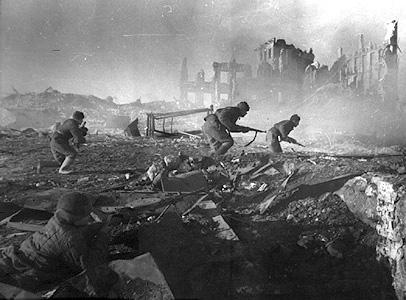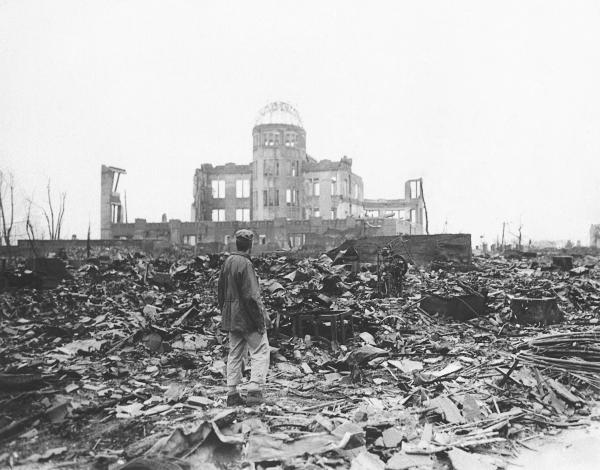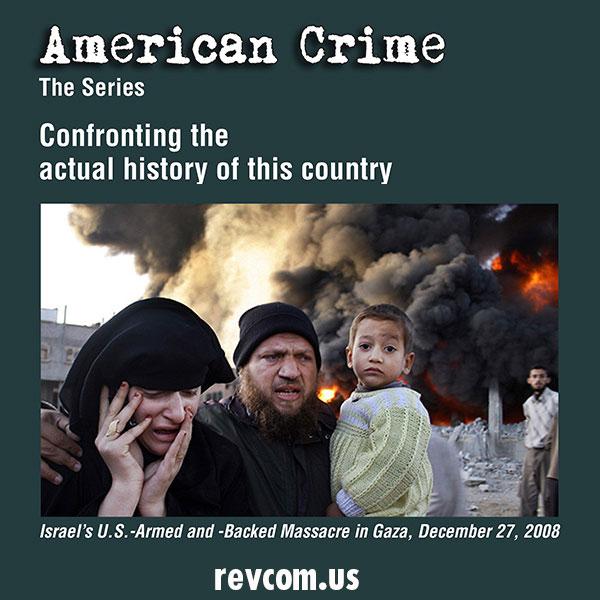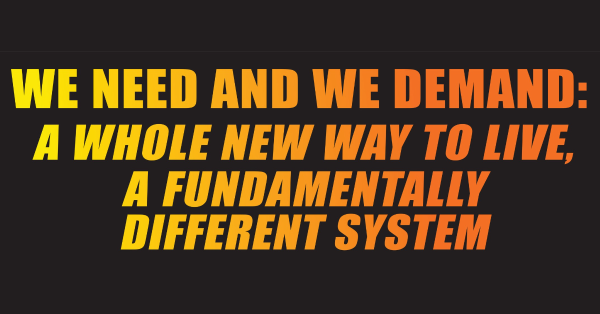In beginning to take out the powerful piece Allegiance as an important part of re-polarizing for revolution, one thing revcoms ran into among youth at one school was the often-heard claim that the U.S. has done at least some good around the world. Two arguments raised in particular were that it was the U.S. military that defeated the Nazis and Hitler’s Germany in World War 2—and that the U.S. atomic bombings of the Japanese cities of Hiroshima and Nagasaki in 1945 were justified because they “saved American lives.”
Given the high percentage of ROTC participation at this school (and in many other schools around the country), it would not be surprising if the ROTC drums such lies into students to indoctrinate young people with the notion that the U.S. military is a “force for good” in the world. These youth are being trained as killing machines—"mindless accomplices, of the injustice, degradation, and devastation of this system of capitalism-imperialism and its terrible consequences for humanity,” as Allegiance puts it—and plunged into a moral cesspool by their teachers. They need some ways to justify their allegiance to the rag they are being trained to kill and die for.
But these two “justifications” are as empty as all the crap about “liberty, and justice, for all”—which Allegiance also shreds.
But you can’t just say that. You gotta bring substance and truth to bear. Revcoms and others getting out Allegiance should eagerly and sharply take on these two arguments—lies—about the U.S. as a “force for good.” Here are excerpts from three articles that will help prepare to debate these points with substance in a convincing way.
On the Lie That the U.S. Defeated the Nazis
The following is from Bob Avakian’s article “The War in Ukraine and the Interests of Humanity: A Scientific Revolutionary Approach vs. Harmful Confusion and Chauvinist Delusion. Bob Avakian Responds to People Who Should Know Better (and Maybe Once Did).”
A War for National Independence, or a “Proxy War” Between Imperialists?
At the heart of this is the question of the actual nature of the war in Ukraine now, and the application, yes, of science to this question, as opposed to muddled thinking strongly influenced by American chauvinism and its distortion of history. This is concentrated in the following argument:
Putin may not be Hitler, but what he’s doing in Ukraine does bring back memories. FDR was right to save Europe from the Nazis, and I’d say Biden is right to do what he can, short of WWIII, to save Ukraine from the Russians. Proxy wars vs. wars of national liberation? Why is Ukraine a proxy for NATO imperialists any more than the NLF [National Liberation Front] and the North Vietnamese were a proxy for Russian and Chinese imperialists? History forces messy choices on us, As I see it, the Ukrainians are fighting for their country as fervently as the NLF fought for theirs. Finally, Bob, I'd like to know what there is in the lived history of revolutionary communism that's worth striving for now.
This is truly a “treasure house” of wrong-headed thinking, strongly influenced precisely by anti-scientific, anti-historical American chauvinism (with a pungent dose of rancid anti-communism). To answer this fully is beyond the scope of what is possible here, but the substance of what is argued here does demand a response. First, in my article with which this argument is disagreeing [“Ukraine: World War 3 Is the Real Danger, Not a Repeat of World War 2”], I spoke to important reasons why comparing Putin and his actions now to what Hitler did leading into World War 2 is wrong, and involves a significant distortion and ignorance (or deliberate ignore-ance) of crucial differences between the situation then and now. I won’t repeat all that here, although one point is definitely worth emphasizing again: both the U.S. and Russia possess thousands of nuclear weapons—weapons which did not exist in the period leading into (and for almost all of) World War 2. But I cannot let pass the statement that “FDR was right to save Europe from the Nazis.” Here is another striking “blind spot” created by the glare of American chauvinism.
If we are going to put things in the rather crude terms of this argument, it was not FDR (Franklin Delano Roosevelt, the U.S. president for most of World War 2) who “saved Europe from the Nazis”—it was much more that old bête noire of anti-communists everywhere, Joseph Stalin. The reality is that it was the Soviet Union, led at that time by Stalin, which broke the back of the NAZI war machine and effectively created a turning point in the war that led to the final defeat of the German NAZIs and their Japanese (and Italian) allies. This is a matter of historical fact (and it was alluded to, for example, by the British leader during the war, Winston Churchill, who acknowledged that the decisive fighting against the NAZIs took place on the eastern front, where the great majority of the NAZI forces were concentrated, against Soviet forces, during the crucial part of the war in Europe).

Soviet soldiers during World War 2 battle at Stalingrad, 1942.
The NAZI attack on the then-socialist Soviet Union, and the Soviet resistance and repulsion of the NAZI invasion, cost the lives of somewhere between 20 and 30 million people in the Soviet Union, along with massive destruction in the Soviet Union itself. Although I have my criticisms of how this war was conducted by the Soviet leadership—including, significantly, that it was waged essentially on a nationalist (and even Great Russian chauvinist) basis, rather than a revolutionary basis—if we take the standard that, mistakenly, attributes to FDR the “saving of Europe from the Nazis,” then the actual defeat of the NAZIs should certainly count among the things that should be celebrated in “the lived history of revolutionary communism,” in this case the Soviet Union. (In fact, there is much in this “lived history” that is “worth striving for now,” even as, with the new communism I have developed, this is, as it needs to be, critically analyzed with a consistently scientific method and approach, identifying in this way both its principal, definitely positive, aspect as well as its secondary but real, and at times even grievous, negative side. I will speak further to this point a little later here.)
On the Lie that the U.S. Carried Out Atomic Bombing of Hiroshima and Nagasaki to “Save American Lives”
The following is from “American Crime Case #97: August 6 and 9, 1945—The Nuclear Incineration of Hiroshima and Nagasaki,” part of the American Crime series at revcom.us.
THE CRIME: At 8:15 am, on August 6, 1945, a blazing, million-degree fireball suddenly appeared just above the Japanese city of Hiroshima, instantly killing, burning alive, or vaporizing tens of thousands. Firestorms engulfed the city. Shockwaves and winds over 1,000 miles an hour came next, shattering bodies and buildings, hurling men, women, and children through the air. Nearly all structures were destroyed over a mile from ground zero.
“There were red burned and bloated dead bodies piled up high, the corpses with the guts and the eyes popped out, lines of ghost-looking people with burned frizzled hair and burned skin hanging,” one survivor recalled, and “barely living survivors who were not able to save their own children or parents.” In one room, there were 20 young men whose eyes had melted in their sockets. Clouds of dust turned the morning into twilight; later, black rain fell.
The U.S. had just exploded the first nuclear bomb over the center of a city of 350,000. Thousands who survived the blast soon experienced fevers, diarrhea, vomiting, hair and skin loss—the death knell of radiation sickness. By the end of 1945, between 140,000 and 150,000 people, overwhelmingly civilians, had perished in Hiroshima. Hundreds of thousands more were wounded.
Later that day, President Harry Truman announced the bombing and threatened Japan: “If they do not now accept our terms [for immediate surrender] they may expect a rain of ruin from the air, the likes of which has never been seen on this earth.” Three days later, on August 9, the U.S. dropped an even more powerful nuclear bomb on Nagasaki, destroying the city and murdering another 70,000 people.
THE CRIMINALS: President Harry S. Truman, who ordered the attack; U.S. Secretary of War Henry Stimson, who oversaw the war effort, including the building of this "most terrifying weapon ever known in human history"; General Leslie Groves, in charge of building the bomb; and the military command responsible for the bombing.
THE ALIBI: Dropping a nuclear bomb on Japan was needed to quickly end the war, avoiding a U.S. invasion which Presidents Roosevelt and Truman claimed would cost a million American lives.
“I realize the tragic significance of the atomic bomb.... We have used it in order to shorten the agony of war, in order to save the lives of thousands and thousands of young Americans,” Truman stated after nuking Hiroshima and Nagasaki.
This alibi has been repeated by all presidents since: “What I think the president does appreciate is that President Truman made this decision for the right reasons,” said President Obama’s press secretary.

THE ACTUAL MOTIVE: Control of Japan and post-World War 2 global domination. The U.S. knew Japan would collapse without an invasion and was suing for peace weeks before Hiroshima and Nagasaki. On July 12, 1945, Truman admitted in his private diary that the U.S. had received a “telegram from [the] Jap Emperor asking for peace.”
But the U.S. rulers wanted to totally control post-war Japan, prevent the Soviet Union from gaining more ground in Japanese-held Manchuria and having more influence in the post-war setup—or “get in so much on the kill,” as one U.S. official put it. This meant terrorizing Japan into surrendering immediately. That’s why the U.S. incinerated Hiroshima and then Nagasaki. Japan surrendered on August 15, six days after the Nagasaki bombing. These were also warnings to any who might think about challenging America’s dominance of the postwar world, written in mounds of charred flesh and many tens of thousands of horribly disfigured survivors.
REPEAT OFFENDER: The U.S. has repeatedly considered and threatened the use of nuclear weapons to enforce its global dominance: In the 1950s, the U.S. planned for possible nuclear war with the Soviet Union, which they calculated would have killed 600 million; in 1958, 1973, and 1980 it put its forces on nuclear alert during Middle East crises in Iraq, Israel, and Iran; in 1969 President Richard Nixon threatened to nuke Vietnam; before the 2003 invasion of Iraq, the Pentagon secretly prepared for the possibility of using nuclear weapons; Obama [had] announced plans to spend over $1 trillion in the next 30 years on new nuclear weapons.
***
The following is from the revcom.us article “On Oppenheimer and the U.S. Decision to Drop the Atomic Bomb. Some Relevant Points of Historical Background and Understanding.”
The nuclear incineration of Hiroshima and Nagasaki is best understood not as the end of World War 2 in the Pacific but rather the opening of the Cold War1 between the U.S. and the Soviet Union. The U.S. dropped atomic weapons as a “statement,” as a warning and threat, to the then-socialist Soviet Union—an act of what historian Gar Alperovitz has called “atomic diplomacy.”2
This was also a message to the whole world. The U.S. had emerged from World War 2 as top imperialist gangster—and the U.S. was telling the world “not to mess with us” or this is what you will get.
The evidence shows that the Japanese had already indicated through diplomatic channels their willingness to surrender. There was little direct military value in destroying Hiroshima and Nagasaki, two largely civilian targets; and, obscenely, the gruesome patterns and effects of immediate destruction of the bombings were carefully studied by U.S. military experts for future application. This is an unspeakably cruel, large-scale, high-tech crime against humanity... for which no U.S. government and president, Democrat or Republican, has ever apologized….
[T]he defining feature and principal aspect of World War 2 was that it was an inter-imperialist war between two blocs of major imperialist powers (Germany, Japan, Italy, on the one hand; and the U.S., Great Britain, France, on the other). They were fighting for global domination and for control over colonies and neocolonies in Africa, Asia, the Middle East, and Latin America…



